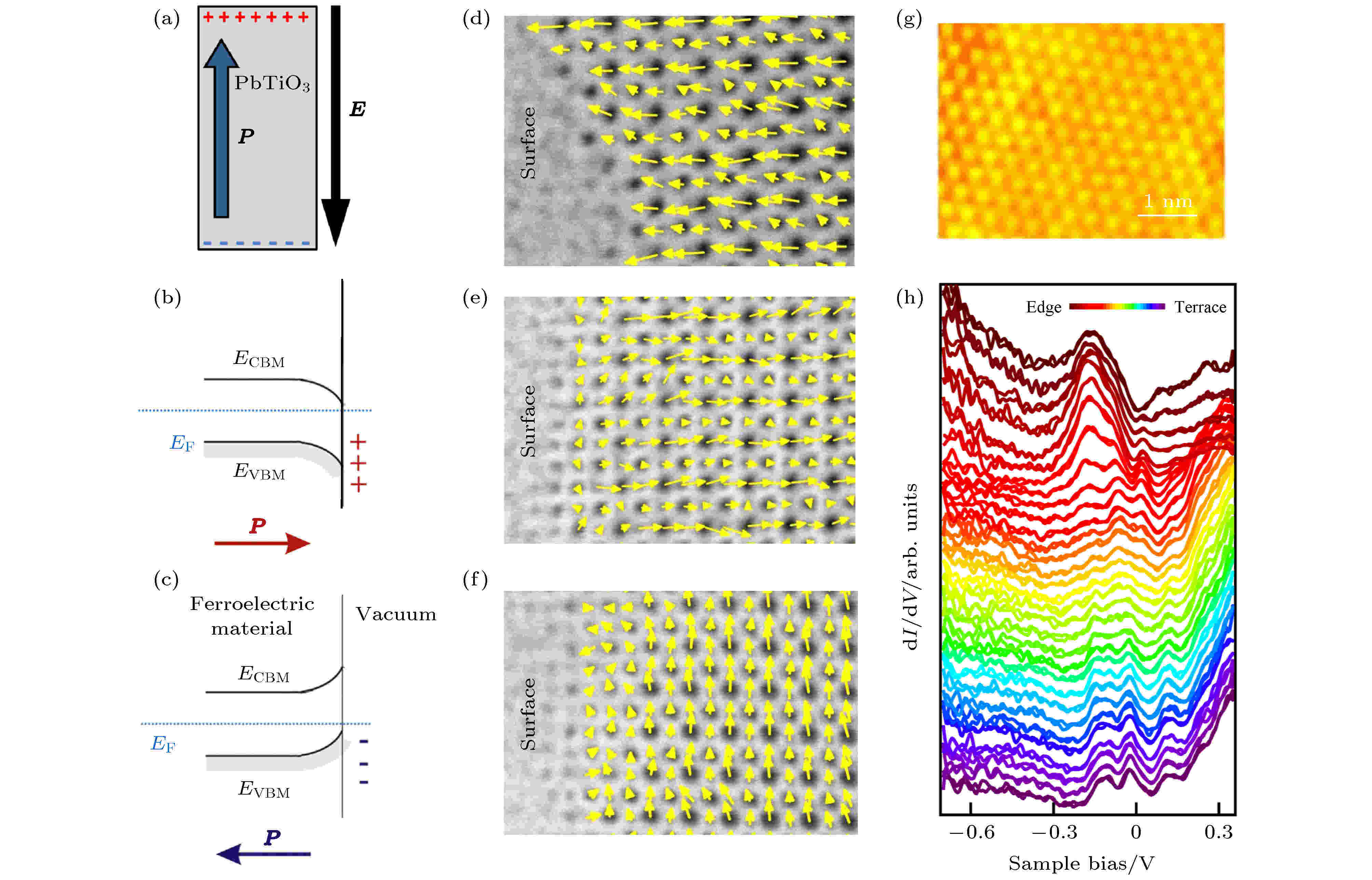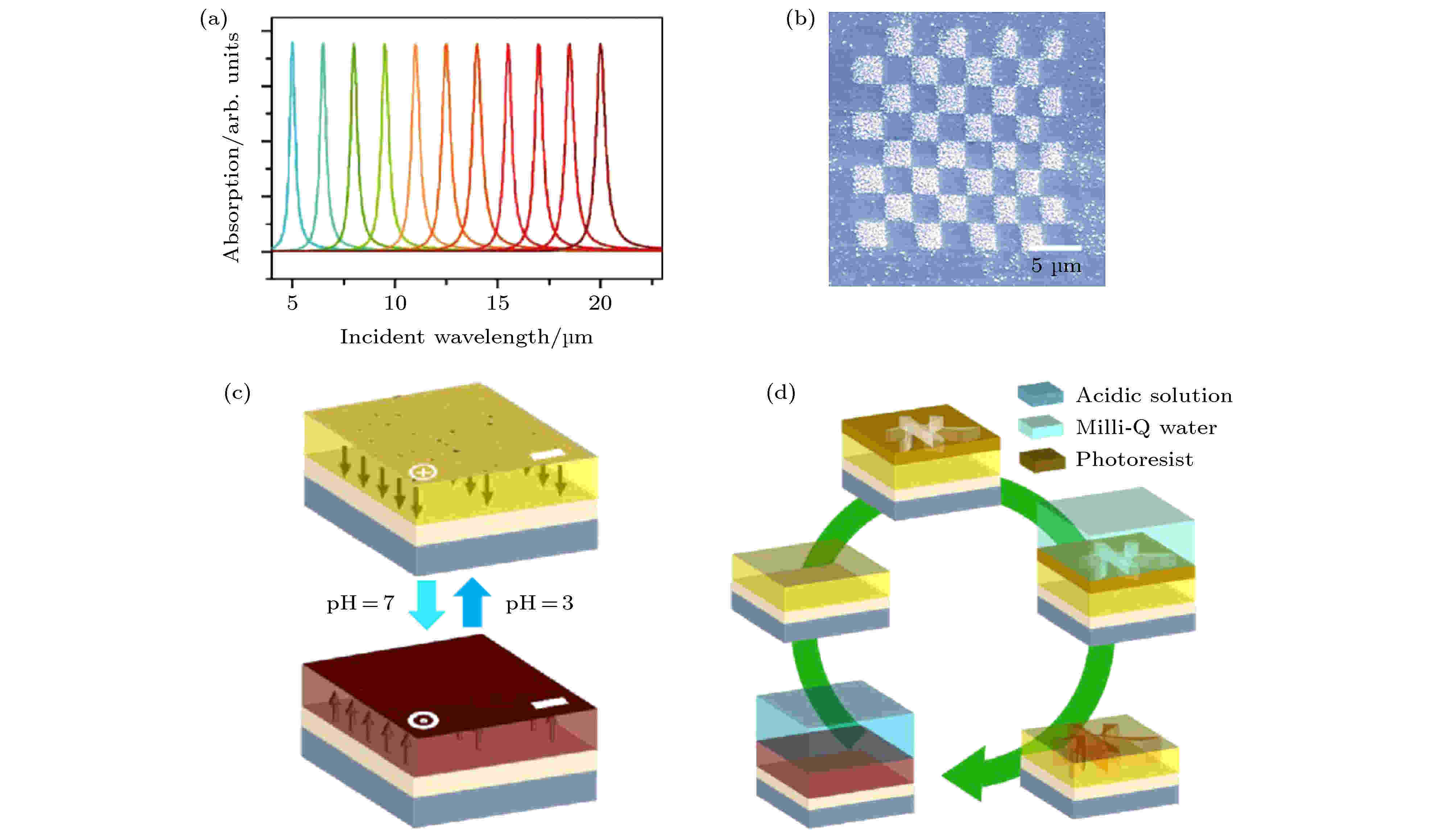全文HTML
--> --> --> 图 1 利用钙钛矿型铁电氧化物独特表面性质的相关应用, E代表电场, P代表极化
图 1 利用钙钛矿型铁电氧化物独特表面性质的相关应用, E代表电场, P代表极化Figure1. Related applications utilizing the unique surface properties of perovskite-type ferroelectric oxides, E represents electric field, P represents polarization.
铁电极化会使材料上下表面/界面具有正负极化电荷层(束缚电荷层), 这导致了材料内部形成一个恒定的退极化场, 如图2(a)所示[21,22]. 退极化场会使材料表面处能带发生弯曲, 极化向外(从铁电体指向真空)或向内(从真空指向铁电体)分别使能带向下或向上弯曲, 不同方向的能带弯曲促使材料在外部环境下通过表面吸附或脱附带不同电荷的粒子来进行表面电荷补偿, 从而加固铁电相的稳定, 如图2(b)和图2(c)所示[23]. 如生长在SrRuO3(SRO)电极上的铁电体PbTiO3 (PTO), 导电的SRO可以在底部提供补偿电荷, 与表面Pb结合的OH或O的上覆层会稳定向外的极化, 而与表面O结合的H的上覆层则会稳定向内的极化[24]. Gao等[25]发现极化向外的Pb(Zr0.2Ti0.8)O3 (PZT)铁电薄膜表面会形成大量Pb空位进行电荷补偿; 但极化向内的PZT薄膜表面存在高密度的用于屏蔽极化的O空位, 从而造成表面晶格扩张形成铁电“死层”; 而当极化方向平行于表面时, PZT薄膜表面的Pb或O空位会影响表面Pb—O键的构型, 从而形成带电荷的90°畴壁, 如图2(d)—(f). 当铁电表面有补偿电荷时, 带正极化电荷区域的表面实际上是负电位, 带负极化电荷区域的表面实际上是正电位, 这与铁电体BaTiO3 (BTO)或BiFeO3 (BFO)的实验测试结果一致[26,27]. 另外, Ying等通过对铁电体BTO (110)理论计算得到, 以化学计量BaTiO-和O2-为终结面的表面能带结构与体态相比发生了强烈的变化, 这种表面重构的形成也可作为电荷补偿的方式[28]. 总之, 钙钛矿型铁电氧化物能够吸附或脱附带电粒子、改变化学计量等方式实现表面电荷补偿, 进而抵消体系的宏观偶极矩.
 图 2 (a) 束缚电荷引起的退极化场, E代表电场, P代表极化[21]; (b) 极化向外导致铁电体表面处能带向下弯曲; (c) 极化向内导致铁电体表面处能带向上弯曲, ECBM代表导带底的能量, EVBM代表价带顶的能量, EF代表费米能[23]; PZT薄膜的正极性表面(d)、负极性表面(e)和面内畴区域(f)的阳离子和阴离子之间的位移图[25]; (g) BWO (113)表面原子分辨率的STM图; (h) BWO薄膜从体态表面到边缘态的dI/dV曲线的演变[30]
图 2 (a) 束缚电荷引起的退极化场, E代表电场, P代表极化[21]; (b) 极化向外导致铁电体表面处能带向下弯曲; (c) 极化向内导致铁电体表面处能带向上弯曲, ECBM代表导带底的能量, EVBM代表价带顶的能量, EF代表费米能[23]; PZT薄膜的正极性表面(d)、负极性表面(e)和面内畴区域(f)的阳离子和阴离子之间的位移图[25]; (g) BWO (113)表面原子分辨率的STM图; (h) BWO薄膜从体态表面到边缘态的dI/dV曲线的演变[30]Figure2. (a) Depolarization field caused by bound charge, E represents electric field, P represents polarization[21]; (b) the downward band bend at an ideal ferroelectric surface with outward (↑) polarization; (c) the upward band bend at an ideal ferroelectric surface with inward (↓) polarization, ECBM represents the energy of the conduction band minimum, EVBM the energy of the valence band maximum, EF Fermi energy[23]; vector maps of the displacement between the cation and anion columns of positively poled surface (d), negatively poled surface (e) and the domain with the in-plane polarization (f) about PZT thin films[25]; (g) atomic resolution STM image of BWO (113) surface; (h) evolution of dI/dV curves of BWO thin film when approaching from the terrace to the edge[30].
除此之外, 钙钛矿型铁电氧化物的表面会出现电子轨道杂化导致表面电子态的重新分布, 这也能降低材料的表面能从而稳定材料表面. Zhu等[29]发现铁电体BFO (111)表面处Fe 3d轨道电子和Bi 6p轨道电子或O 2p轨道电子会发生杂化作用, 这种表面电子态密度的重新分布使BFO表面更加稳定. 同样, 本课题组最近使用扫描隧道显微镜(scanning tunneling microscope, STM)发现在层状的Bi2WO6 (BWO) (113)薄膜台阶边沿出现一种新的表面金属态, 这是由于暴露的O 2p轨道电子引起表面电子态密度的重构来使表面能最小化, 如图2(g)和图2(h)[30]. 另外, 还发现表面原子弛豫会导致铁电材料表面的几何构型与体态不一致, 此类表面重构导致材料表面的电子结构发生变化, 从而可以有效降低体系的总能量. 例如, Dai等[31]通过理论计算发现, 以Fe-O3-Bi三层堆垛为终结面的BFO的表面能最小, 而且负极性表面最外层的Fe原子层形成了明显向内的弛豫, 但位于正极性表面的O原子层出现显著的面内旋转重构, 这些表面原子弛豫导致的表面重构可以使材料具有稳定的表面原子构型. 综上所述, 受铁电极化、外部环境、表面重构等因素的影响, 钙钛矿型铁电氧化物形成的表面结构十分复杂, 而且目前对铁电材料表面科学的理解和掌握还不够充分, 因此对铁电表面、界面结构的研究需要更加深入的开展.
 图 3 (a) LNO的正极性和负极性表面对异丙醇脱附的数据比较[32]; (b) LNO的正极性和负极性表面对乙酸、异丙醇和十二烷脱附的β/TP2-TP图[33]; (c) 电解质溶液中极化向内的铁电薄膜上方的双电层结构和对应电势的示意图; (d) 带负电荷的探针与极化向内或向外的铁电薄膜之间的双电层结构和相互作用力[37]; 极化向外(e) 和向内(f) 的BFO表面分别吸附 H+ (e) 和 OH– (f) 后极化翻转的示意图[26]
图 3 (a) LNO的正极性和负极性表面对异丙醇脱附的数据比较[32]; (b) LNO的正极性和负极性表面对乙酸、异丙醇和十二烷脱附的β/TP2-TP图[33]; (c) 电解质溶液中极化向内的铁电薄膜上方的双电层结构和对应电势的示意图; (d) 带负电荷的探针与极化向内或向外的铁电薄膜之间的双电层结构和相互作用力[37]; 极化向外(e) 和向内(f) 的BFO表面分别吸附 H+ (e) 和 OH– (f) 后极化翻转的示意图[26]Figure3. (a) Comparison of 2-propanol desorption from positively and negatively poled LNO[32]; (b) plots of β/TP2 versus TP for desorption of acetic acid, 2-propanol and dodecane from positively and negatively poled LNO[33]; (c) schematic of the electric double layer structure above an inward-polarized ferroelectric thin film in an electrolyte solution and a corresponding sketch of the potential; (d) the electric double layer structure and interaction force between a negatively charged probe and a ferroelectric thin film with inward or outward polarization[37]; schematic diagrams show BFO polarizations are switched from outward/inward to inward/outward after surfaces adsorbed H+ (e) or OH– (f), respectively[26].
另外, 当钙钛矿型铁电氧化物与液体接触时, 极性表面会通过静电相互作用吸引溶液中与其电性相反的离子, 从而在固液界面处形成双电层结构, 包括内亥姆霍兹层(inner-Helmholtz plane, IHP)和外亥姆霍兹层(outer-Helmholtz plane, OHP)[35-37]. 其中, 双电层的电势分布可近似用Poisson-Boltzmann方程来表示[36]:









除了上述利用铁电极化调控铁电体的表面/界面结构外, 通过调节外部环境也可以调控钙钛矿型铁电氧化物的表面/界面结构[26,39]. 如Wang等[40]发现通过控制外部环境的氧压来调控PTO超薄铁电薄膜表面氧空位的含量, 并且由于钙钛矿型铁电氧化物薄膜中氧空位是表面电荷补偿的主要组成部分, 因此这种表面氧空位浓度的调控还会导致PTO薄膜的极化方向发生改变. 另外, 通过调节外部环境的湿度可以控制铁电体LNO和BTO单晶表面水分子的吸附量, 进而影响铁电体表面能的大小[41,42]; 还有研究者[43,44]发现, 水分子与BTO表面之间会产生电荷迁移, 导致铁电材料表面电子重构, 表面处的原子产生相对位移. 这些水分子与铁电材料表面接触时发生的表面能大小、表面电子结构的改变都会进一步影响铁电极化的方向[41-44]. 除了物理吸附外, 本课题组近期通过控制液体中H+, OH– 与BFO薄膜表面原子的相互作用, 从而在BFO表面构建了金属-氧-氢键(M—O—H), 这种BFO表面新化学键的形成及对BFO表面化学结构的调控, 还会导致铁电薄膜体极化的翻转, 如图3(e)和图3(f)[26]. 因此, 通过调节外部环境使材料表面处发生的物理吸附、化学成键等可以有效调控铁电体的表面结构, 并且这些表面结构的改变还会进一步导致铁电极化的改变.
总而言之, 通过控制铁电极化能够实现有效地调控材料的表面/界面结构及其表面物理化学特性; 另外通过调节外部环境也能实现对铁电表面/界面结构的调控, 并且也会进一步影响体极化等物理性质, 这些对铁电表面/界面结构的调控机制为钙钛矿型铁电氧化物表面性能、功能的控制提供了重要的研究基础.
4.1.铁电表面/界面物理性质的调控及其应用
通过调控钙钛矿型铁电氧化物的表面结构, 可以影响材料表面的物理性质, 从而可以将其调控机制应用在相关领域中. 如铁电畴的取向会影响材料表面气体分子的吸附, 这为气相传感器件的开发提供了新的平台[7]. 钙钛矿型铁电氧化物与液体接触会在界面形成亥姆霍兹双电层结构, 这种双电层结构可以使铁电材料与液体界面处形成离子梯度, 从而应用在界面传感装置中, 如图4(a)所示[35]. 另外, 这种带有高电荷密度的铁电材料表面及其双电层结构还可以被用于非易失性存储的场效应晶体管中, 通过改变铁电极化方向调控铁电材料表面的正负补偿电荷浓度, 控制沟道的导通与断开从而实现数据的写入与读取, 如图4(b)所示[45,46]. 图 4 (a) 钙钛矿型铁电氧化物与液体界面形成离子梯度[35]; (b) 双电层晶体管示意图[46]; 示意图展示了钙钛矿型铁电氧化物表面电荷诱导的pH梯度(c)、极性大分子的高度变化(d), 以及利用铁电材料的表面电场控制溶液中带电粒子的流动方向(e) [35]; (f) 带正电的纳米膜植入体表面与带负电的内源性骨缺损壁之间形成内建电场[10]
图 4 (a) 钙钛矿型铁电氧化物与液体界面形成离子梯度[35]; (b) 双电层晶体管示意图[46]; 示意图展示了钙钛矿型铁电氧化物表面电荷诱导的pH梯度(c)、极性大分子的高度变化(d), 以及利用铁电材料的表面电场控制溶液中带电粒子的流动方向(e) [35]; (f) 带正电的纳米膜植入体表面与带负电的内源性骨缺损壁之间形成内建电场[10]Figure4. (a) Ionic gradient is formed in the interface between perovskite-type ferroelectric oxides and liquid[35]; (b) a schematic of the electric double-layer transistor[46]; schematic diagrams show pH gradients (c) and macromolecular height change (d) are induced by surface charges of perovskite-type ferroelectric oxides; and (e) the flow direction of charged particles in solution is controlled by the surface electric field of ferroelectric materials[35]; (f) a built-in electric field is formed between the electropositive nanofilm implant surface and electronegative endogenous bone defect wall[10].
除此之外, 通过控制铁电畴的大小、方向还可以调控极性表面的微区pH梯度、溶液中的极性大分子在界面的吸附及排列方式、控制溶液中带电粒子的流动方向等, 如图4(c)—(e)所示[35,47]. 例如, BFO铁电薄膜可以通过控制其表面附近的离子浓度促进成骨细胞的增殖和分化, 表面带正电的BFO薄膜与带负电的内源性骨缺损壁之间形成内建电场, 改善了蛋白质吸附和干细胞的黏附、扩散和迁移, 促进了前期成骨细胞的增殖, 如图4(f)所示, 然而到后期细胞分化阶段, 表面带负电的BFO薄膜则表现更好的促进作用[10]. 另外由于装载的药物在不同的极性表面上受到不同的静电作用力, 其脱离表面的分解速率会有差异, 因此铁电材料可被制成药物释控自成装置来实现控制药物释放[35,48]. 总之, 通过调控钙钛矿型铁电氧化物的表面结构及其物理性能, 使其在界面传感、信息存储、微流控制、生命科学等领域发挥积极的作用也已成为目前研究的热点.
2
4.2.铁电表面/界面化学反应的调控及其应用
钙钛矿型铁电氧化物除了可以通过静电相互作用调控材料表面、固液界面的物理性质外, 还可以通过调控表面结构进而控制材料表面的化学反应. 铁电体的自发极化引起的退极化场和能带弯曲不仅能够有效降低电子和空穴的复合, 从而提高表面化学反应效率, 而且还可以通过控制铁电极化的方向调控表面结构, 进而对材料表面的化学反应产生影响[49,50]. 由于钙钛矿型铁电氧化物表面处的能带会发生弯曲, 光生电子或空穴会由于内建电场和表面能带弯曲的作用从体相迁移至表面, 表面附近电子结构的变化决定了可用于发生表面反应的载流子类型, 从而特定地选择材料表面的化学反应类型[51]. 如Ag+离子在极化向外的铁电表面被还原成Ag颗粒, 并吸附沉积在BTO表面; 而在极化向内的铁电表面会发生氧化反应, 使Pb2+离子成为Pb4+离子, 如图5(a)和图5(b)[52,53]. 因此改变铁电极化方向可以使同一铁电材料的光生载流子发生不同方向的迁移, 这实现了材料本身即可以作为光阳极使光生空穴到达表面参与析氧反应, 又可以作为光阴极使光生电子到达表面参与析氢反应[54]. 另外, 铁电薄膜表面特殊的晶界和畴壁(如带电荷畴壁)处由于电荷屏蔽和能带弯曲等原因促进载流子迁移至反应物, 也可使特定的化学反应发生[55,56]. 如本课题组最近发现BWO (001)铁电薄膜中带有负或正束缚电荷的畴壁可以诱导出双功能光电极行为, 如图5(c)和图5(d)所示[57,58]. 总之, 通过改变铁电极化进而调控钙钛矿型铁电氧化物的表面结构, 能够提高材料的光催化反应活性和控制铁电表面的化学反应, 这可以为反应催化剂、绿色能源开发和环境保护方面的应用提供了新的思路. 图 5 极化向外(a)或极化向内(b)的BTO与Ag+还原电位、Pb2+氧化电位的能带结构图, EV代表价带顶的能量, EC代表导带底的能量, EF代表费米能, P代表极化[53]; (c)和(d) 分别展示了BWO(001)中带不同电荷畴壁的水分解示意图[57]; (e) 计算模拟通过动态翻转PTO的铁电极化可以实现将一氧化氮合成为氮气和氧气的过程示意图; (f) 铁电极化调控分子与表面相互作用的示意图[11]
图 5 极化向外(a)或极化向内(b)的BTO与Ag+还原电位、Pb2+氧化电位的能带结构图, EV代表价带顶的能量, EC代表导带底的能量, EF代表费米能, P代表极化[53]; (c)和(d) 分别展示了BWO(001)中带不同电荷畴壁的水分解示意图[57]; (e) 计算模拟通过动态翻转PTO的铁电极化可以实现将一氧化氮合成为氮气和氧气的过程示意图; (f) 铁电极化调控分子与表面相互作用的示意图[11]Figure5. Energy band structure of BTO with outward (a) or inward (b) polarization and Ag+ reduction potential, Pb2+ oxidation potential, respectively, EV is the valence band edge, EC the conduction band edge, EF the Fermi level, P polarization[53]; (c) and (d) show the schematics of water splitting mechanism of different charged domain walls in BWO (001), respectively[57]; (e) simulation shows the decomposition process of nitric oxide into nitrogen and oxygen can be realized by dynamically switching ferroelectric polarization of PTO; (f) schematic of molecule-surface interaction controlled by ferroelectric polarization[11].
自20世纪初以来, 萨巴捷原则(Sabatier principle)对最佳催化剂的思考提供了一个概念框架, 而其也成为了化学催化的基石之一[59]. 该理论认为, 催化剂表面与原子和分子的吸附要有合适的相互作用, 这种作用既不能太弱, 以便能够推动反应进行; 也不能太强, 以便将反应产物脱附, 这说明了吸附和脱附之间不可避免的妥协. 为使这种相互作用尽可能地优化, Kakekhani[11]提出了一种基于铁电材料的动态循环催化理论模型, 试图克服萨巴捷原则对催化活性的一些限制, 使许多条件要求苛刻的催化反应能够实现, 例如将一氧化氮气体分解为氮气和氧气, 如图5(e)和图5(f)所示. 该方案通过可逆地控制铁电材料的极化方向来作为化学反应的有效开关, 使具有强吸附势或强解吸势的表面态之间进行切换, 这种铁电表面化学作用的动态循环控制可能为催化材料的设计及其工艺开辟全新的途径.
2
4.3.铁电体表面纳米畴结构设计与功能调控及其应用
除了上述对钙钛矿型铁电氧化物表面的物理性质以及化学反应调控外, 微纳尺寸的铁电表面局域电场的调控(纳米铁电畴结构调控)及其应用开发一直受到研究者们的青睐[12,60]. Guo等[12]提出利用BFO周期性的极性表面(周期性铁电畴结构调控)对石墨烯施加周期性电场, 以增强入射光子的吸收, 可以诱导出可调谐的吸收峰和产生5—20 μm探测能力的超高光响应, 这种利用周期性铁电畴调谐的石墨烯等离子体光电探测器有望克服现有的基于活性石墨烯的光电探测器响应速度慢和光吸收能力有限的缺点, 如图6(a)所示. 另外, 通过对钙钛矿型铁电氧化物纳米畴结构的设计和制备来调控局域电子结构和表面电场, 能够控制材料表面的物理化学特性. 如Kalinin等[61]利用PZT微纳尺寸的铁电畴结构调控表面电子结构, 以控制材料表面局域的化学反应, 如图6(b)所示. Christophis等[62]也在周期性微纳尺寸的铁电畴结构的LiTaO3(LTO)表面发现扩散的成纤维细胞避免在畴壁这种高电场梯度的位置上黏附, 因此可以通过设计微纳尺寸的铁电畴、畴壁结构调控表面电场分布进而精确定位细胞生长. 一般钙钛矿型铁电氧化物纳米畴结构的设计、制备可以通过在表面电极外加电压、利用原子力探针外加电压、电子束辐射、飞秒激光照射或化学腐蚀等方法[63-65], 最近发现利用离子相互作用控制铁电极化并结合微纳光刻技术实现了可“擦写”铁电极化的大面积“印刷”技术, 这为高效制备基于铁电体纳米畴结构的功能器件提供了强有力的支持, 如图6(c)和图6(d)所示[26]. 总之, 开发设计以钙钛矿型铁电氧化物微纳尺寸的、周期性的铁电畴结构为基础的器件, 可以在光学、生物医学、集成传感器和无线通信等领域有着广泛的应用前景. 图 6 (a) 基于铁电畴调谐的石墨烯等离子体光电探测器的自驱动微型光谱仪的吸收特性, 目标光谱范围从5—20 μm[12]; (b) 扫描探针显微镜观察到的具有周期性畴结构的PZT薄膜上的Ag光沉积[61]; (c) BFO薄膜暴露在酸性溶液(pH = 3)后的铁电极化翻转为向内, 暴露在纯水溶液后极化翻转为向外; (d) 将BFO暴露在不同pH值的水溶液中, 印刷和消除铁电极化的原理图[26]
图 6 (a) 基于铁电畴调谐的石墨烯等离子体光电探测器的自驱动微型光谱仪的吸收特性, 目标光谱范围从5—20 μm[12]; (b) 扫描探针显微镜观察到的具有周期性畴结构的PZT薄膜上的Ag光沉积[61]; (c) BFO薄膜暴露在酸性溶液(pH = 3)后的铁电极化翻转为向内, 暴露在纯水溶液后极化翻转为向外; (d) 将BFO暴露在不同pH值的水溶液中, 印刷和消除铁电极化的原理图[26]Figure6. (a) The absorption characteristics of a self-driven micro-spectrometer based on the graphene plasmonic photodetector tuned by ferroelectric domains, the target spectrum ranges from 5 to 20 μm[12]; (b) Ag photodeposition on the PZT thin film with periodic domain structure observed by scanning probe microscopy[61]; (c) the ferroelectric polarization of BFO thin film is switched to inward after being exposed to acidic solution (pH = 3) and then outward after being exposed to Milli-Q water; (d) the schematic of printing and erasing the ferroelectric polarization by exposing the BFO to aqueous solution with different pH value[26].
